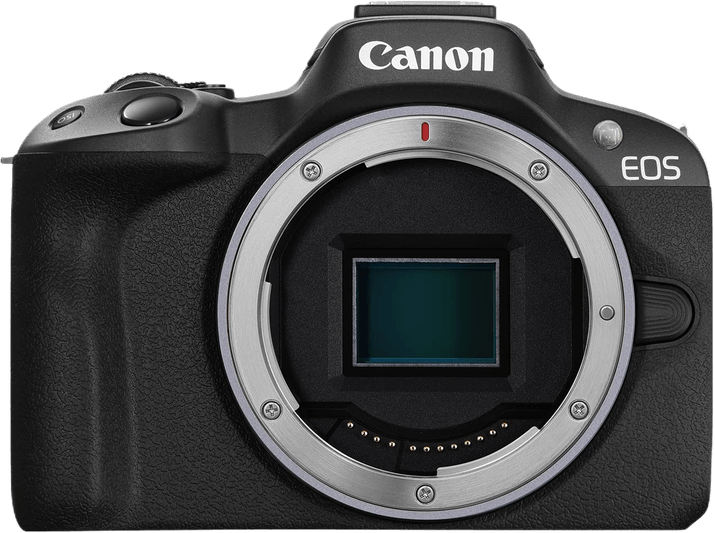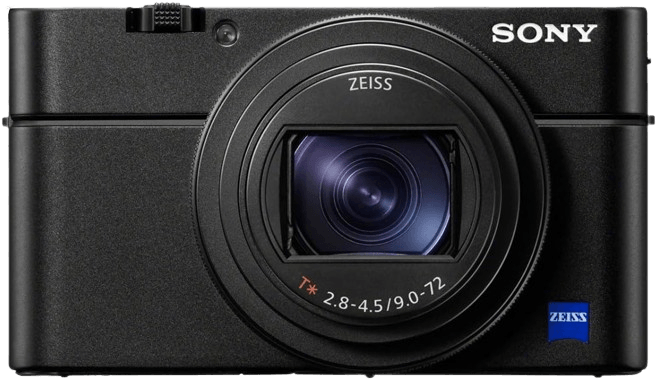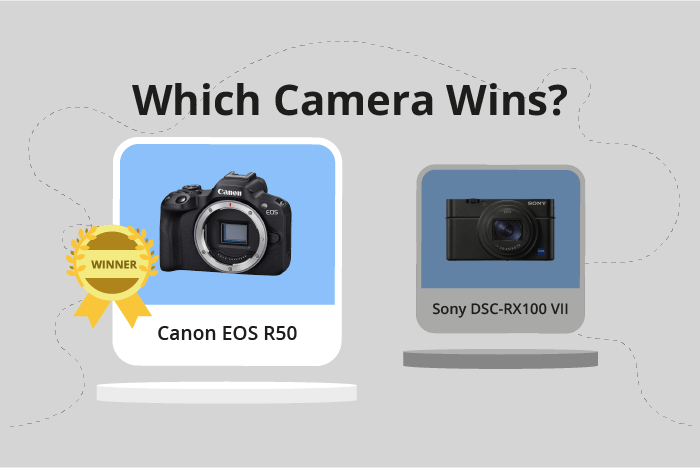Canon EOS R50 vs Sony Cyber-shot DSC-RX100 VII Comparison
Canon EOS R50

Sony RX100 VII

The Canon EOS R50 outperforms the Sony Cyber-shot DSC-RX100 VII with a score of 70/100 compared to 60/100. Both cameras share common features, such as being mirrorless and compact, as well as having similar announcement and release dates.
The Canon EOS R50, however, stands out with a more affordable launch price of $679, compared to the Sony’s $1200. Additionally, the EOS R50 has a larger camera size (116 x 86 x 69mm) and a slightly heavier weight (375g), which may provide better handling and stability for some users.
On the other hand, the Sony Cyber-shot DSC-RX100 VII has a smaller size (102 x 58 x 43mm) and lighter weight (302g), making it more portable and easier to carry around. However, this advantage does not outweigh the benefits of the Canon EOS R50’s better performance and lower price.
Taking everything into account, the Canon EOS R50 proves to be a better choice for most users due to its performance, affordability, and handling, while the Sony Cyber-shot DSC-RX100 VII may be a suitable option for those prioritizing portability.
Canon EOS R50 vs Sony Cyber-shot DSC-RX100 VII Overview and Optics
The Canon EOS R50 triumphs over the Sony Cyber-shot DSC-RX100 VII in terms of optics, scoring 73/100 compared to the Sony’s 61/100. Both cameras share common features such as a CMOS sensor and a similar megapixel count, with the Canon having 24 megapixels and the Sony having 20. However, the Canon surpasses the Sony in several aspects.
The Canon boasts a higher shooting speed of 12, while the Sony lags behind with a shooting speed of 5. Additionally, the Canon’s sensor has a DXOMARK score of 94, significantly higher than the Sony’s 63. This difference contributes to the Canon’s superior image quality. Furthermore, the Canon EOS R50 is equipped with an APS-C sensor size and a Canon RF lens mount, allowing for greater flexibility and versatility in choosing lenses.
Despite its lower score, the Sony Cyber-shot DSC-RX100 VII does have some advantages over the Canon. It features image stabilization, which the Canon lacks. This can be beneficial for photographers who need to capture steady images in challenging conditions. However, the Sony’s fixed lens mount limits the user’s ability to change lenses and adapt to different shooting situations.
Taking these factors into account, the Canon EOS R50 emerges as the superior camera in terms of optics. Its higher shooting speed, better sensor score, and versatile lens mount make it a more attractive option for photographers seeking high-quality images. While the Sony Cyber-shot DSC-RX100 VII does have the advantage of image stabilization, its limitations in other areas prevent it from outshining the Canon.
Canon EOS R50 vs Sony Cyber-shot DSC-RX100 VII Video Performance
The Canon EOS R50 and the Sony Cyber-shot DSC-RX100 VII both have a video score of 91/100, making them equally competitive in terms of video capabilities. Both cameras share similar video features, including a maximum video resolution of 4K, dimensions of 3840 x 2160, a maximum video frame rate of 120fps, and built-in time-lapse functionality.
The Canon EOS R50 stands out with its superior ergonomics and design, making it a more comfortable option for extended video shooting sessions. The camera’s user interface is also more intuitive, allowing videographers to access settings and features more efficiently.
On the other hand, the Sony Cyber-shot DSC-RX100 VII has a compact size, making it a more portable option for on-the-go video shooting. This camera is ideal for travel videography or situations where carrying larger equipment may be inconvenient.
Both cameras provide excellent video quality, and the choice between them comes down to personal preferences and specific needs. The Canon EOS R50 is better suited for those who prioritize ergonomics and ease of use, while the Sony Cyber-shot DSC-RX100 VII is the preferred choice for videographers who value portability and compactness.
Ultimately, the Canon EOS R50 and the Sony Cyber-shot DSC-RX100 VII are both strong contenders in the video camera market. With their equal video scores and shared specifications, the decision between these two cameras depends on the individual preferences and requirements of the videographer.
Canon EOS R50 vs Sony Cyber-shot DSC-RX100 VII Features and Benefits
The Canon EOS R50 wins in the features comparison with a score of 72/100, while the Sony Cyber-shot DSC-RX100 VII scores 68/100. Both cameras have a 3-inch touchscreen, flip screen, and do not have GPS. They also come with WIFI and Bluetooth connectivity.
The Canon EOS R50 outperforms the Sony Cyber-shot DSC-RX100 VII in terms of screen resolution. The R50 has a screen resolution of 1,620,000 dots, which provides a sharper and more detailed display compared to the RX100 VII’s 921,000 dots. This higher resolution benefits photographers in framing and reviewing their shots with more accuracy.
On the other hand, the Sony Cyber-shot DSC-RX100 VII does not have any distinct advantages over the Canon EOS R50 in the features department. Both cameras share similar functionalities, and the difference in scores is mainly due to the screen resolution.
Considering the Canon EOS R50’s superior screen resolution and the shared features with the Sony Cyber-shot DSC-RX100 VII, the R50 is the better choice in terms of features. However, the RX100 VII remains a viable option for those who prioritize other aspects such as size, weight, or other specifications not covered in this comparison. Ultimately, the decision should be based on individual preferences and requirements.
Canon EOS R50 vs Sony Cyber-shot DSC-RX100 VII Storage and Battery
The Canon EOS R50 outperforms the Sony Cyber-shot DSC-RX100 VII in storage and battery with a score of 35/100 compared to Sony’s 29/100. Both cameras have one memory card slot and support USB charging. They accept SD, SDHC, and SDXC cards, while the Sony model also supports Memory Stick Pro Duo.
The Canon EOS R50 has a better battery life, providing 370 shots per charge, using the LP-E17 battery type. In contrast, the Sony Cyber-shot DSC-RX100 VII offers 260 shots per charge with its NP-BX1 battery. This difference gives the Canon EOS R50 an advantage for longer shooting sessions.
On the other hand, the Sony Cyber-shot DSC-RX100 VII has the added benefit of supporting Memory Stick Pro Duo cards, providing users with an additional storage option. This versatility might be advantageous for some users.
Considering these factors, the Canon EOS R50 is superior in battery life, making it more suitable for extended use. The Sony Cyber-shot DSC-RX100 VII offers an extra storage option, but its lower battery life may limit its usability in certain situations.
Canon EOS R50 vs Sony Cyber-shot DSC-RX100 VII – Our Verdict
Are you still undecided about which camera is right for you? Have a look at these popular comparisons that feature the Canon EOS R50 or the Sony Cyber-shot DSC-RX100 VII:

